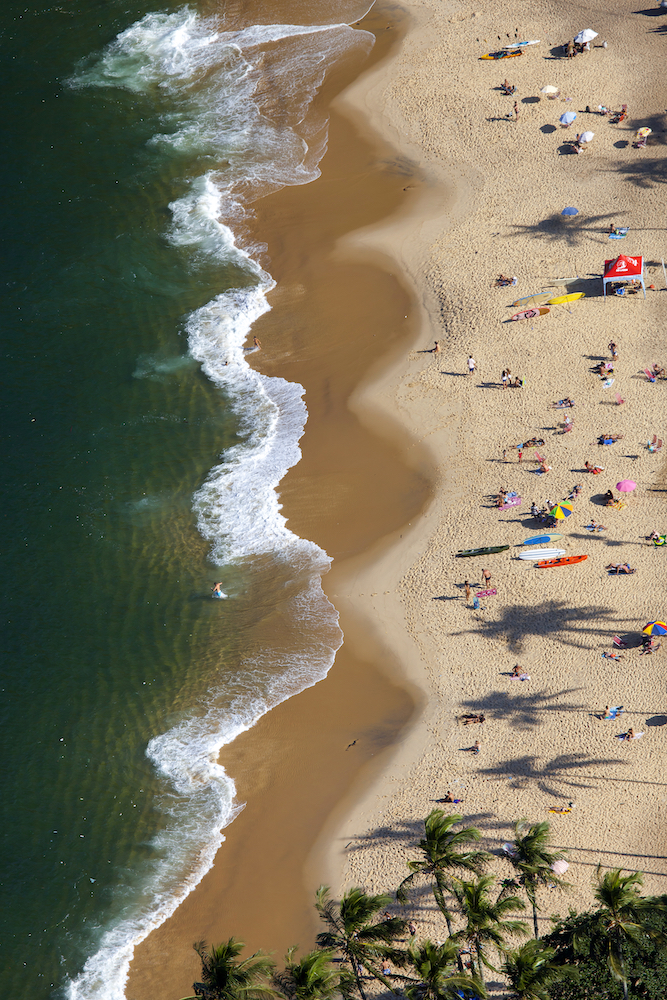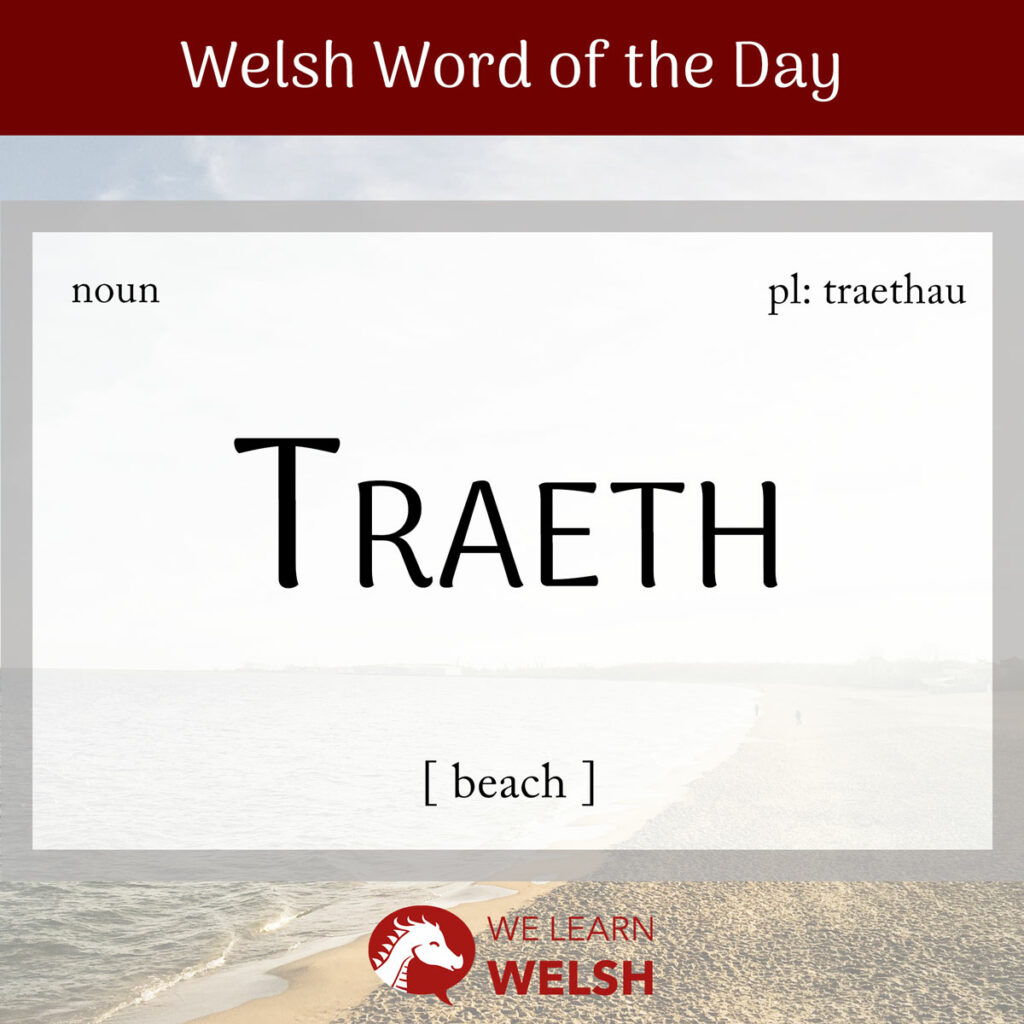Cymru (Wales) is famous for its miles and miles of arfordir (coast) – 1680 to be exact. In fact, aside from the land border with Lloegr (England), this small country is surrounded entirely by moroedd (seas).
Môr Iwerddon (the Irish Sea), Môr Celtaidd (the Celtic Sea), Môr Cymru (St George’s Channel / Welsh Sea), and Môr Hafren (the Bristol Channel / Severn Sea) together ensure that no matter where you are in Cymru, you’re never far from y traeth (the beach).
The plural of traeth is traethau (beaches).
traeth
beach
Like with many Welsh words that have an ae / ai / au sound, people in South Wales tend to colloquially pronounce traeth with a long a sound instead.
It’s a bit confusing at first. However, if you live in South Wales or are focussing mostly on the Southern dialect, give copying this pronunciation a go – it’ll really help you fit in and sound really natural when you’re chatting to Southern speakers!
The root of traeth is the proto-Celtic word *tragi, meaning low tide. Unlike many other proto-Celtic words, it’s survived in all six of the living Celtic languages. Traeth is tràigh in Scots Gaelic, traie in Manx, traezh in Breton, treth in Cornish and trácht in Irish.
As it’s a masculine noun, traeth doesn’t mutate after the definite article – we saw this in the phrase y traeth above. But you still need to be aware of all three mutations of this word, as there are various other circumstances in which the mutations will come up.
Soft mutation
draeth
Nasal mutation
nhraeth
Aspirate mutation
thraeth
There’s often some overlap between the words for beach, seaside, and coast in many languages, and traeth can be used to refer to any of these.
For example, although I’ve translated it for the purposes of this article as beach, traeth is the go-to translation for coast in a lot of place names. The West African country Côte d’Ivoire / Ivory Coast is y Traeth Ifori, and Australia’s Gold Coast is y Traeth Aur.
It also covers situations that aren’t beachy at all. Traeth awyr (air beach / sky beach) is a phrase used to describe the sky when it’s full of small, rippling cymylau (clouds). In English, it’s sometimes called mackerel sky.
Another interesting example is the Welsh word for quicksand, which is traeth gwyllt (wild beach) or traeth byw (living beach). A more formal term—though I doubt formality is a priority if you ever find yourself discussing quicksand!—is sugndraeth (sucking beach).
Most often, traeth is used to refer to an area of land situated ar lan y môr (by the seaside) that is covered in either tywod (sand) or cerrig (stones). This makes it pretty much equivalent to the English word beach. Often it’s a place that is considered particularly beautiful, and that people enjoy visiting for day trips or gwyliau (holidays).
But the following semi-synonyms could still come in handy:
- glan (y) môr = seashore / seaside
- morlan = seashore / seaside
- arfordir = coastline
- y glannau = the coast
- cyfordraeth = raised beach
- traethell = small beach / mudflat
- marian = pebbly beach
Remember as well that, despite its versatility, we can’t use traeth as a verb as we can beach in English. For example, to beach a ship is just dod â llong i dir, which literally means to bring a ship to land. Some people might compress this to tirio llong or glanio llong.
Dw i wastad wedi mwynhau darllen ar y traeth.
I’ve always enjoyed reading on the beach.
Across the world, traethau are people’s top choice of location to ymlacio (relax), nofio (swim), and torheulo (sunbathe). The more adventurous may enjoy sports like syrffio / brigo tonnau (surfing), dringo (rock-climbing), plymio (diving) and hwylio (sailing), especially if they’re able to enjoy significant tonnau (waves).
And of course, it wouldn’t be a proper British beach day out without some hufen ia (ice cream) or sglodion (chips).
One of my favourite things to do ar lan y môr is to wildlife-watch, and luckily Cymru is a great place to do just that. Almost every summer at Llangrannog as a child, I was lucky enough to spot dolffiniaid trwynbwl (bottlenose dolphins) playing in the water. Morloi (seals) and llamhidyddion / morhychod (porpoises) were a slightly less common treat, but still very much within the realm of possibility.
The kinds of anifeiliaid (animals) you can see at the traeth vary throughout the country. While Ceredigion (Cardiganshire) is great for dolffiniaid and morhychod, it’s by no means the be all and end all of Welsh wildlife.
Ynys Môn (Anglesey) is known for being a particularly good place for adar (birds), like mulfrain (cormorants), gwenoliaid (terns), and even palod (puffins) due to recent repopulation programs.
And since Sir Benfro (Pembrokeshire) tends to be a bit warmer than other coastal areas of Wales, it’s the perfect place to visit if you’re hoping to spot môr-grwbanod (turtles), sglefrod môr (jellyfish), morgwn (sharks), and even morfilod (whales).
Mae’r traeth ‘ma mor hardd, hyd yn oed yn y glaw.
This beach is so beautiful, even in the rain.

Before we bring this article to a close, let’s cover some of the most useful short phrases you can use to talk about y traeth in Welsh.
- ar y traeth = on the beach
- ar hyd y traeth = along the shore
- mynd i’r traeth = to go to the beach
- ymweld â’r traeth = to visit the beach
- mwynhau’r traeth = to enjoy the beach
- traeth baner las = Blue Flag beach
I think most Welsh people you speak to will have a favourite traeth in Wales, and a strong opinion as to why their choice is best! The truth is, Cymru is blessed with an abundance of traethau, from North to South, each with their own unique appearance, activities, and bywyd gwyllt (wildlife). Do you have a favourite traeth to visit in Wales?

